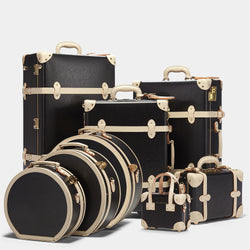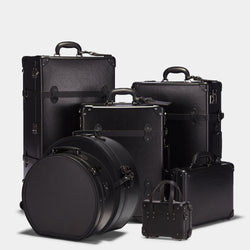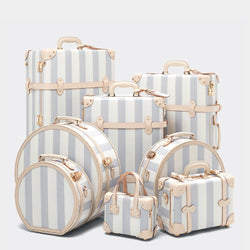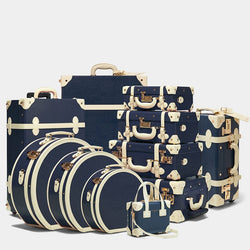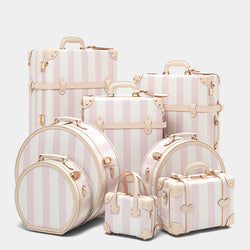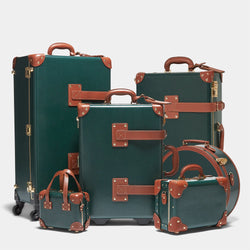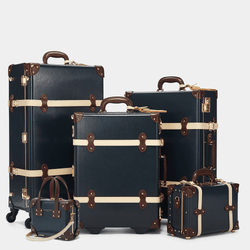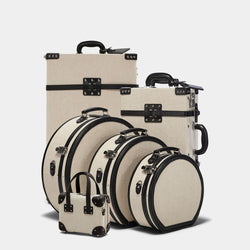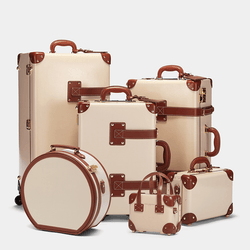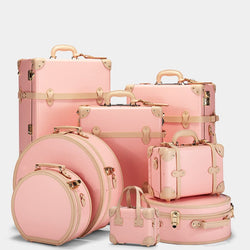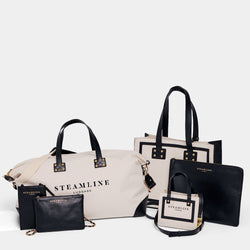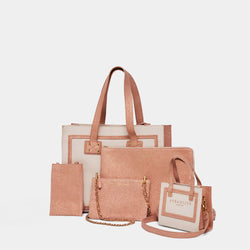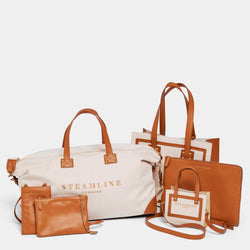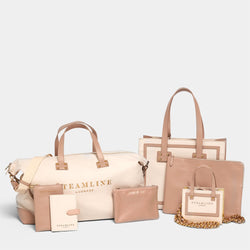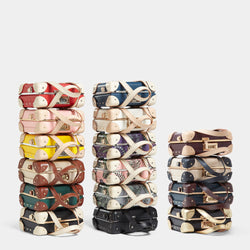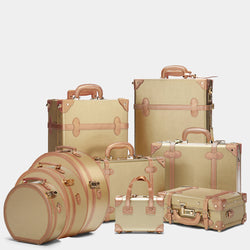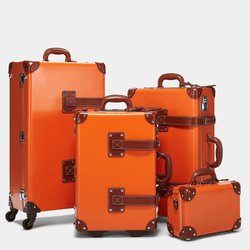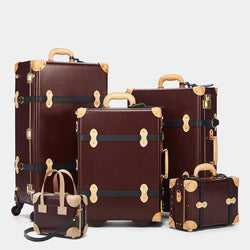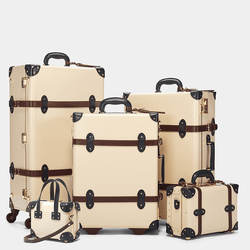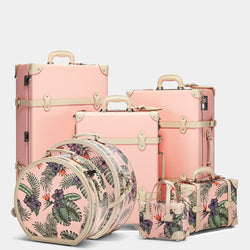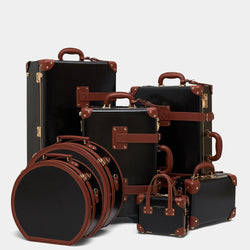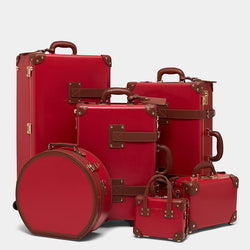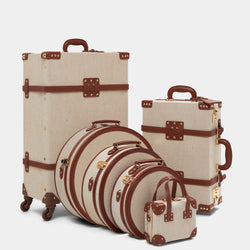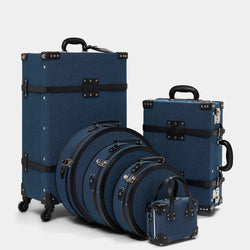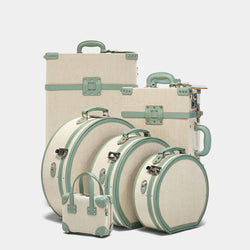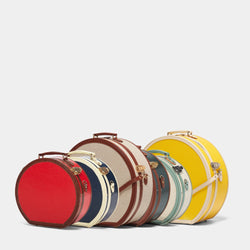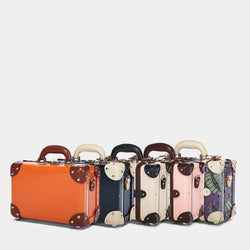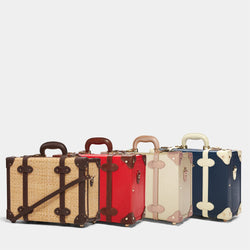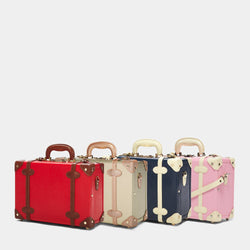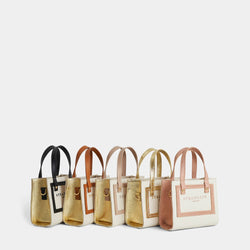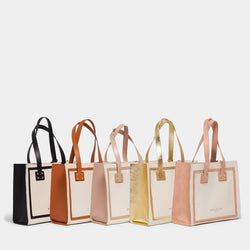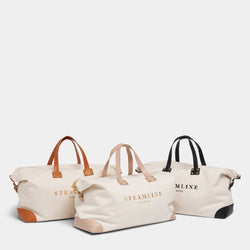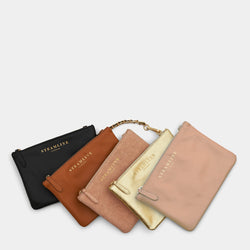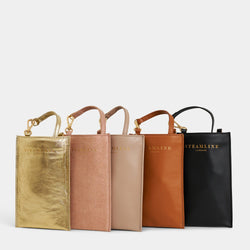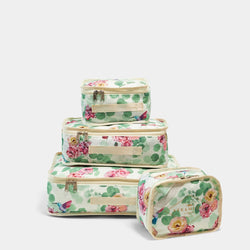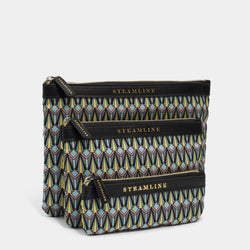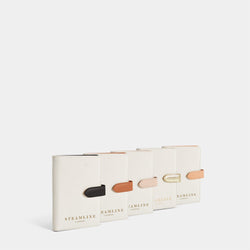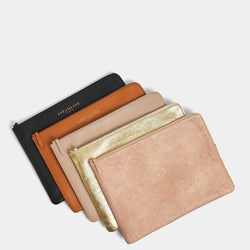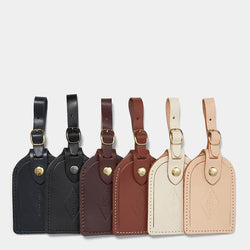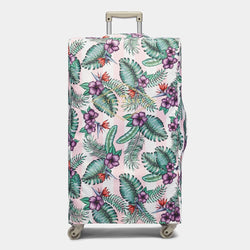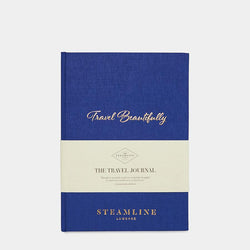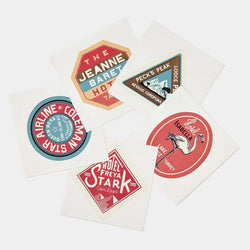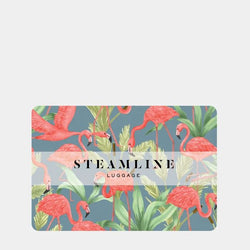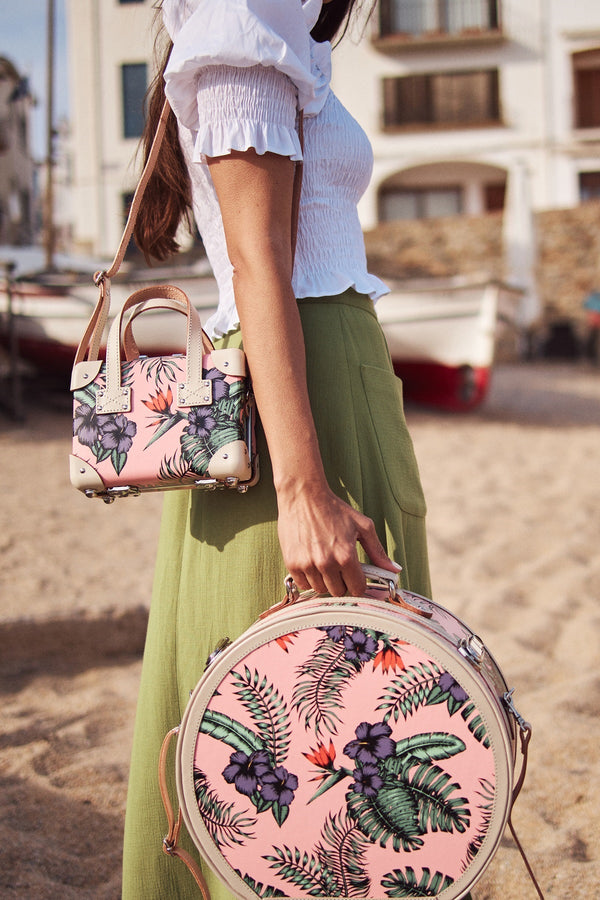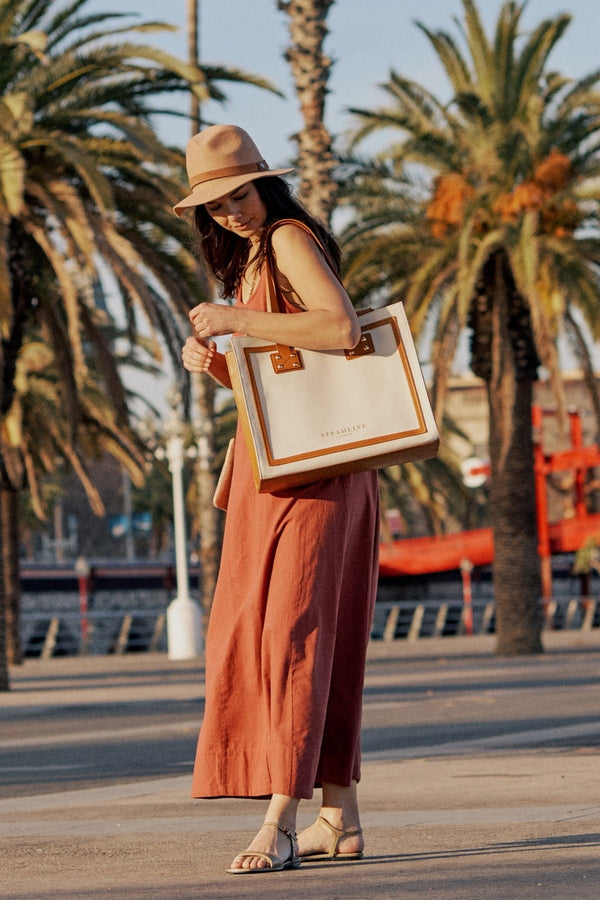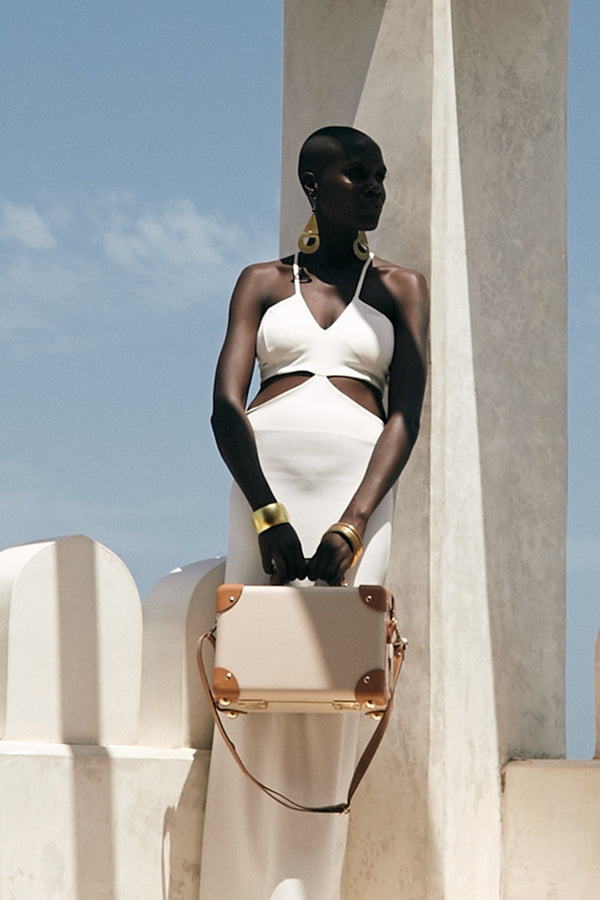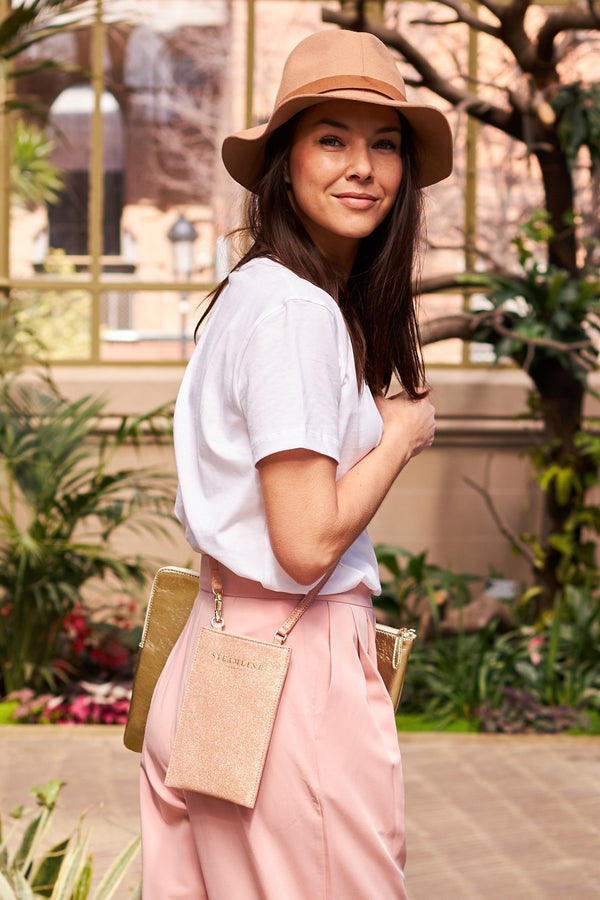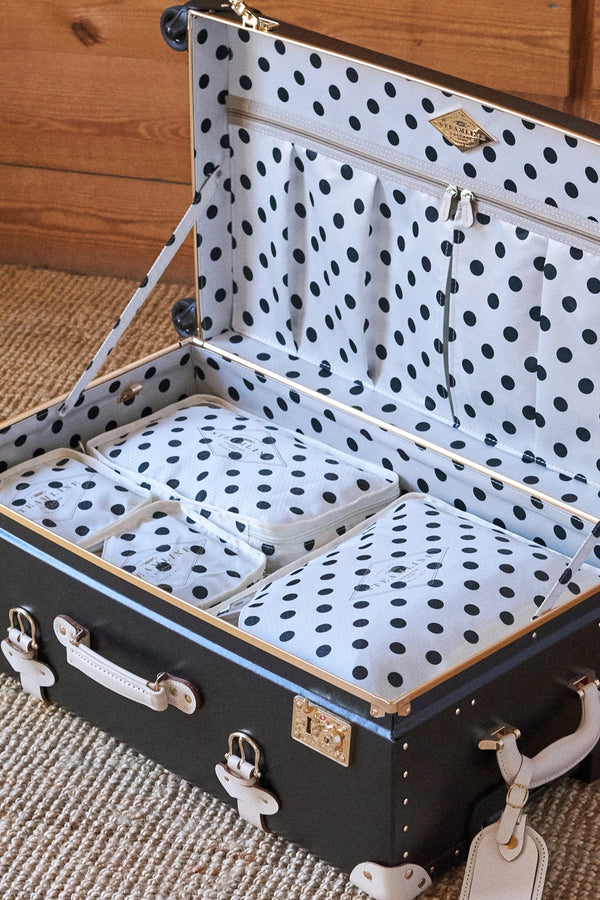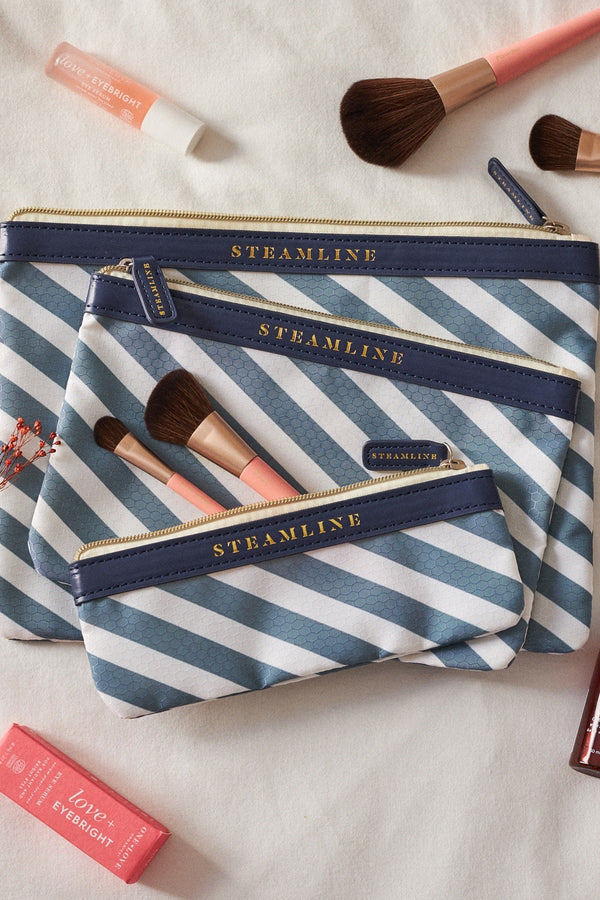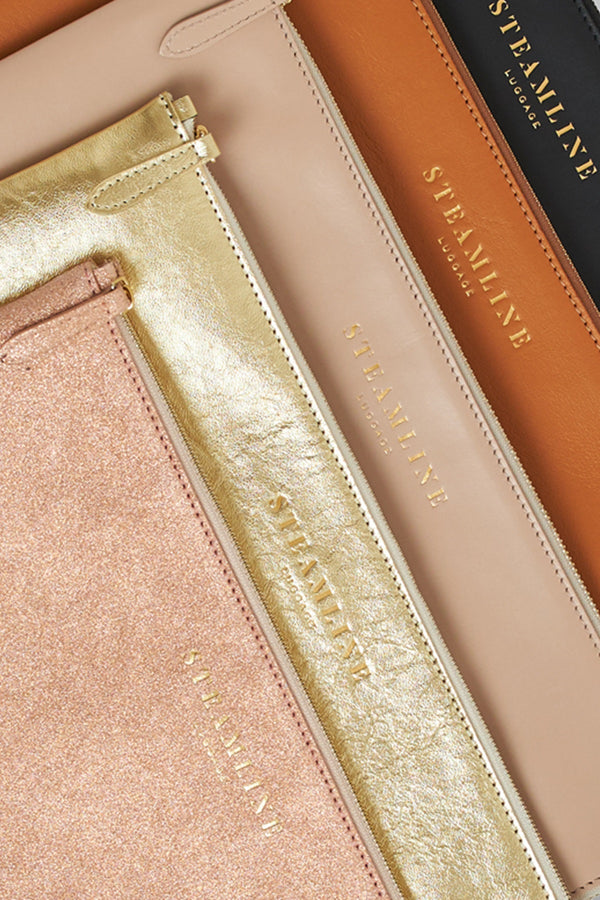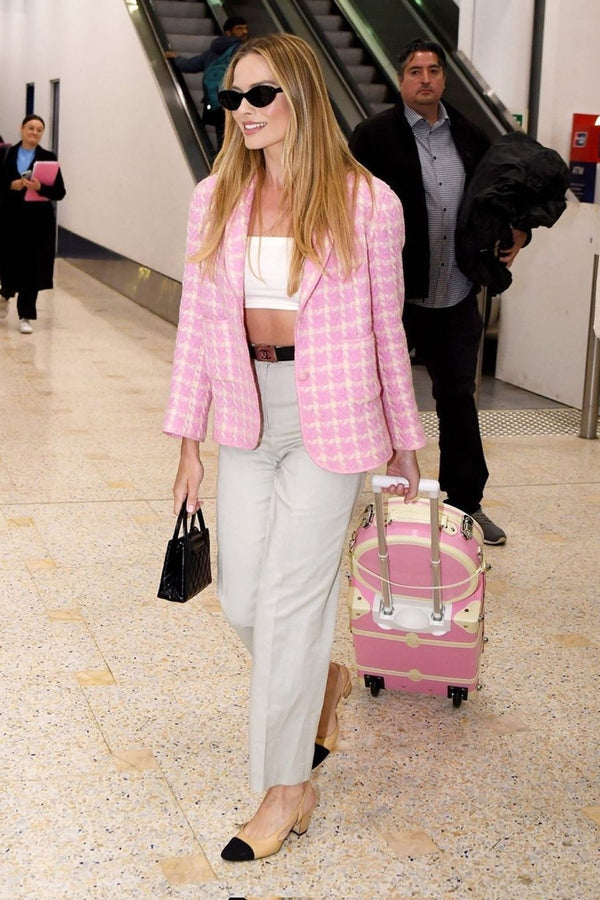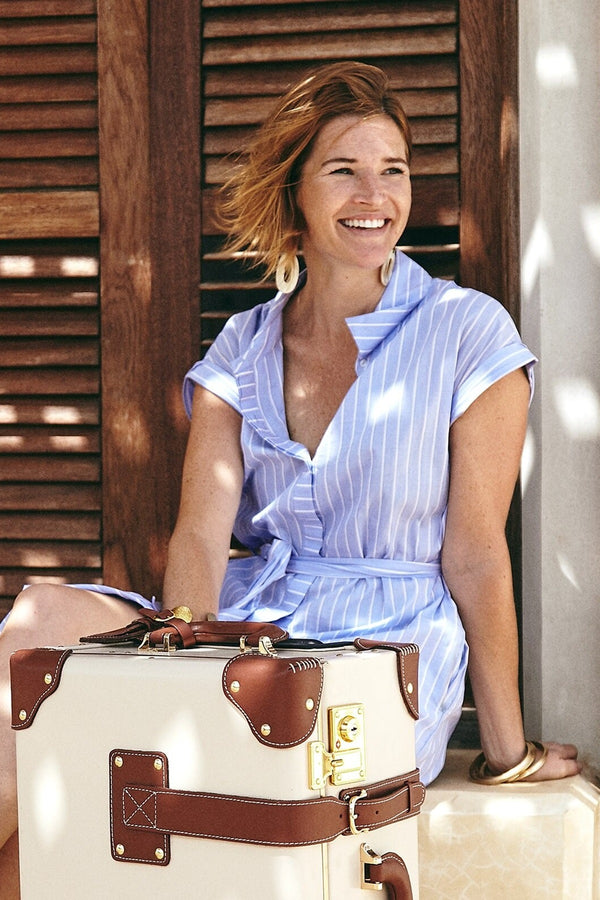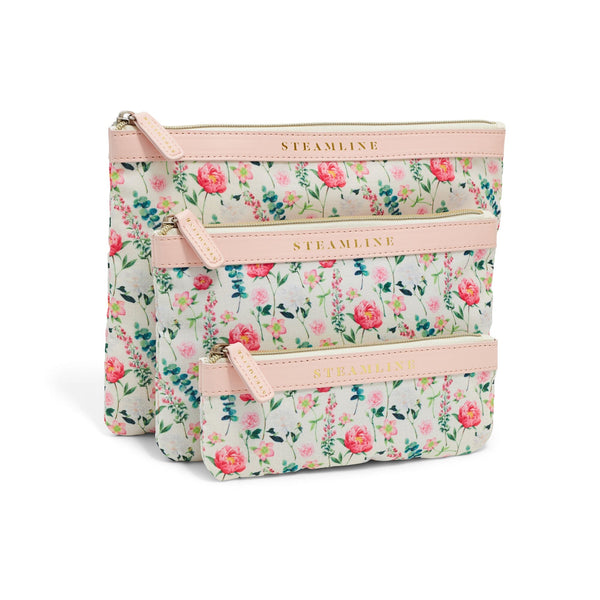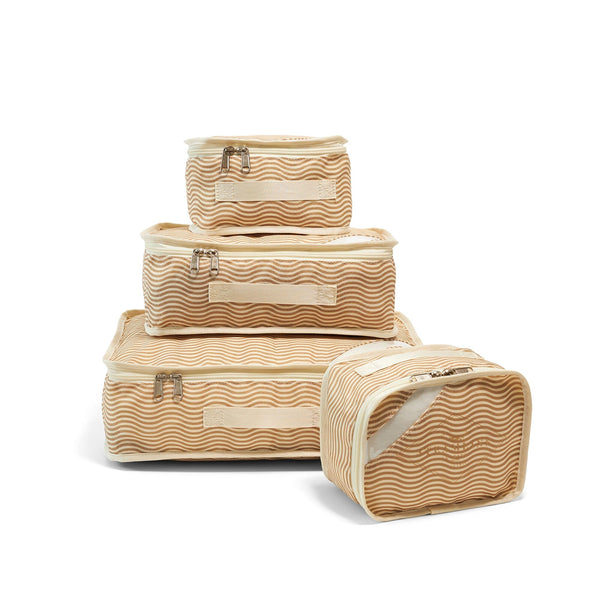The Story of our Annie Atkins Luggage Stickers!
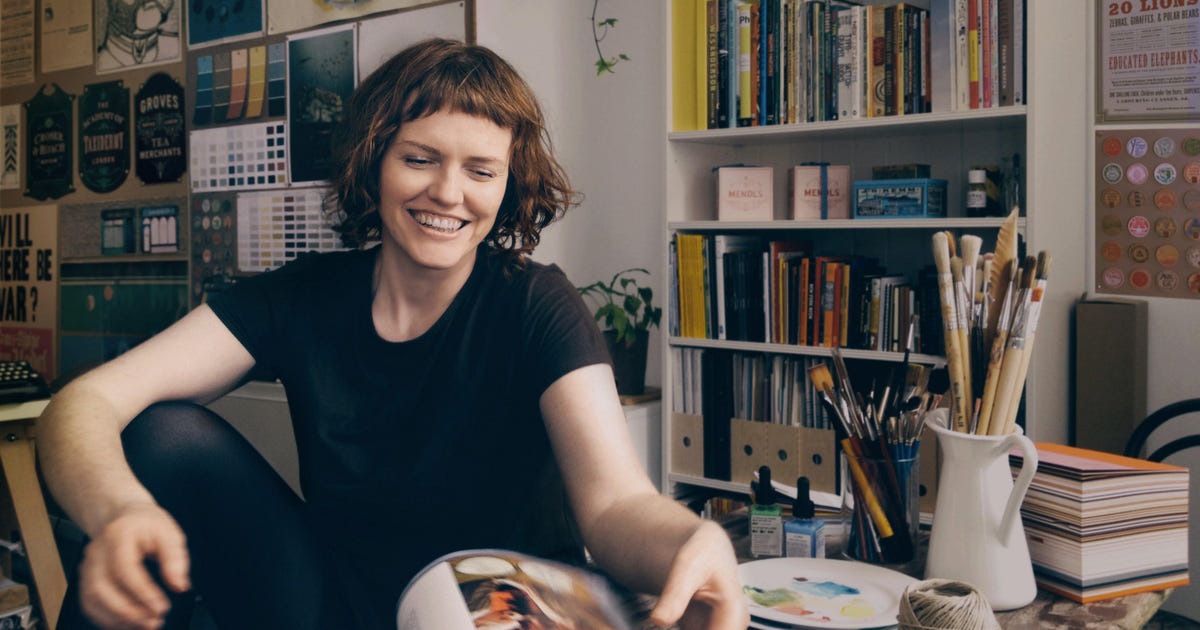
An Interview with our founder, Sara Banks
I have been a longtime fan of Annie Atkins, having first seen her work in some of Wes Anderson's films. When we saw The Grand Budapest Hotel, my husband turned to me and said, "We must contact Annie Atkins!" When I went to Annie's studio for the first time, I was so inspired by not only what she does but how she does it. In her calm, well-organized studio, a couple of assistants worked away with soft music in the background, heads down with pencils, pens, and cutters in hand. On the walls were old typography examples, ticket stubs, maps, postcards, and letters—and it was impossible to tell which was an old artifact or that of her own creation. That is because her creative process is the real deal. Everything is researched based on a time period, no typography placed in a way that wouldn't have been possible for the time. Her attention to detail and the process by which she creates props—all by hand—is unparalleled to anything I have ever seen.
When I showed her our luggage and told her I wanted to do travel stickers (I just really wanted to collaborate with her on ANYTHING), she accepted. I am beyond thrilled to have the final product in our hands, with zero edits, and share all the stories of trailblazing women adventurers. Please enjoy learning more about this project and the brilliant Annie Atkins!

Annie Atkins with her son Mabon and her Diplomat SteamLine customized with the exclusive luggage stickers she designed for our brand!
SB: Congratulations on your book! The title is so amazing, Fake Love Letters, Forged Telegrams, and Prison Escape Maps: Designing Graphic Props for Filmmaking! It is such a visually beautiful portfolio of your work along with some great snippets of your life and experiences in the film industry—not to mention a wonderfully detailed historical snapshot of life during a specific era, that I reckon most history books pass by! I had never heard of ailment suffered by matchmakers “phossy jaw” or that eels would have been the equivalent of a hotdog in the early 1900s. Are you a history buff in general or only when immersed in a period of work? Is it your recent work with the likes of Tudors, Penny Dreadful or Titanic that have sparked this type of research and fact finding?
AA: Thank you so much! I’m very proud of the book. You know, the first publisher I ever took the idea to expressed some doubt over whether it would have an audience—they were worried there wasn’t enough crossover between people interested in graphic design and those interested in props and filmmaking. So I’m very happy that it seems to have found its readership—it turns out there are lots of people out there who love scrutinizing all these little background details in a movie and wondering how they came to be!
Yes, working in film graphics means you really have to immerse yourself in the period of each movie you work on—whether you like it or not. The first weeks on a job before the camera starts rolling are really about learning as much as possible about the time and place as you can, and that can lead to quite disturbing discoveries—I feel like I have way too many facts about Victorian diseases and Tudor brutality than I would ideally like to have in my head. This whole career has been a real education.
 The cover of Annie's gorgeous (largely sold-out) book and some choice images of favourite props from the past.
The cover of Annie's gorgeous (largely sold-out) book and some choice images of favourite props from the past.
"Graphic design in filmmaking has really had a little spotlight shone on it over the past few years. When most of your work is really supposed to be invisible, that’s been a real treat!"
SB: You speak very highly of working with Wes Anderson and his production designer Adam Stockhausen. Their attention to detail and historical accuracy seems to parallel your own. I’m very fascinated with leadership and teamwork; what do you love about working with them?
AA: Oh, working with Wes and Adam has been the absolute highlight of my career. They’re so experimental and genuinely interested in graphic methods from the past. Working on Wes Anderson movies has been such an eye opener for me—and made especially fun as he likes to develop those historical artifacts into such fun, bold, bright things. It’s meant that graphic design in filmmaking has really had a little spotlight shone on it over the past few years. When most of your work is really supposed to be invisible, that’s been a real treat!
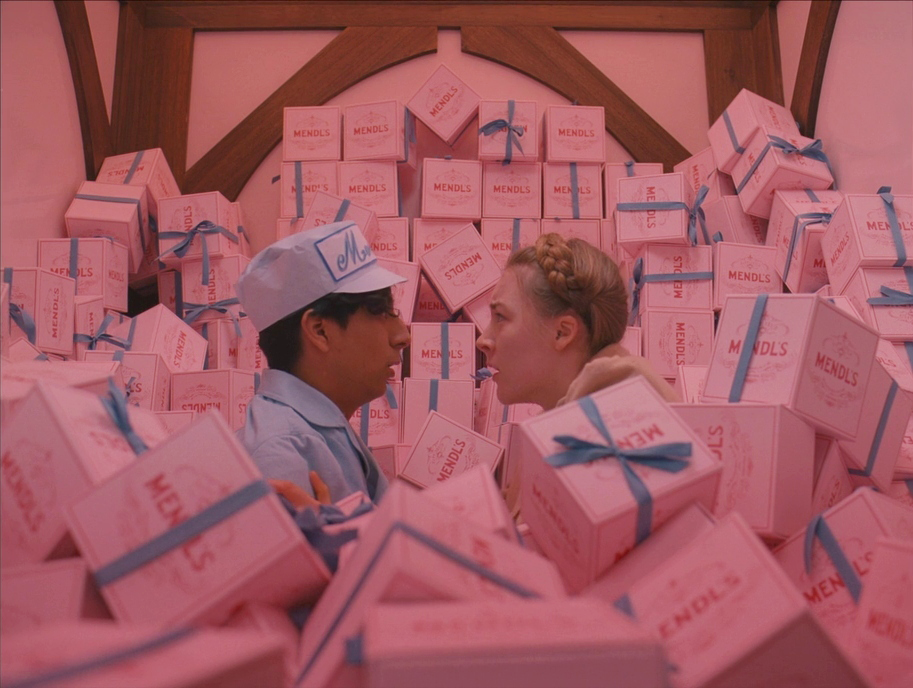
A scene from Wes Anderson's The Grand Budapest Hotel with Saoirse Ronan and Tony Revolori surrounded by Annie's iconic Mendl's box.
SB: What is your leadership/collaborative style and how does your team support you?
AA: When I was working on The Grand Budapest Hotel the rest of the graphics team used to tease me because any time they showed me anything I would always immediately coo over how ‘lovely’ or ‘beautiful’ it was. Was I too enthusiastic about everything? Probably! But these films are hard work and everyone is under enormous pressure, and I just think that starting from a point of ‘this is great’ and then going on to develop it (which we always, always did—we sometimes made up to 20 or 30 iterations of any given prop before it was approved) made for a good working environment. These days I mostly work remotely from my own studio here in Dublin, and my assistants are all my previous workshop students. They’ve all been a huge support to me on various projects over the years—I wanted to give them a special thank you in my book, so I made a fake library card and scanned their names, so they all have their signatures printed in the book now.
SB: Was your mother an artist? (You said that she drew every day of her life...amazing.) How did she inspire you? Were you draw to art from an early age by her?
AA: Yes, my mother was a wildlife illustrator, she and my father had a design business in rural north Wales creating artwork for the heritage sector—information boards at scenic points for the National Trust and the like. When I was little my mum drew every single day. She had piles of sketchbooks filled with drawings of me asleep as a baby. She always said drawing well was just practice. My favourite of hers is of me asleep in the hospital, it says ‘Annie, one day old’ in pencil underneath it—so she was drawing right after giving birth! I think that because my parents were both artists there seemed no question that I would also go that route. But I know that most young designers don’t always have that support; in fact, they can often face opposition to a career in the arts. I try to encourage everyone I meet at design conferences to go for it. There are so many industries that need artists—filmmaking, animation, theatre, advertising, gaming... it’s not the risky career path that it has a reputation of being!

Annie's tools of the trade.
SB: You start most of your projects by hand and then move onto a computer, is that right? Is that what allowed for such an easy segue into prop making?
AA: I flip back and forth between my computer and my drawing board or cutting mat all day pretty much. I do love making things by hand but I also have rose-tinted glasses about it. When you’re on a film production and you have to make twenty cigarette boxes in half an hour it’s not necessarily the pleasurable or meditative craft that I have sometimes made it out to be. My start was on the series The Tudors, about Henry VIII, and before that I had worked in advertising where I worked entirely digitally. So the jump into suddenly designing stained glass or making royal scrolls was a difficult one. I found myself thinking back to my childhood where we’d made so many hand-made crafts. Tea-staining pirate maps, for example, that always comes up again and again in film design!
SB: I am also fascinated with the “postcard versus text message” dichotomy; as someone so often “living” in the past, what is your relationship to social media and the digital world?
AA: Oh, I love Instagram. I love Instagram in ways that I don’t love Twitter, which I seem to use only to grumble about the state of modern affairs. But I find Instagram to be a nice window to a world outside of my studio, and a great place to share work. I know it gets a bad rap for presenting a very rosy glow of life, but honestly I love a bit of filter. I like pretty pictures. That’s what I’m here for!

A postcard from Annie's storied body of forgery.
SB: I love the intro of Chapter 2 in your book on research: “It’s easy to imagine the past as a sepia toned-photograph: monotone street scenes, ghostly figures in formal wear, and serif fonts everywhere. It’s wrong of course—a copy of a copy of copy, until it becomes a cliche. When we do our research, the reality can be surprising and much more interesting.”
One of my favourite stories you told me was on the day we met—that in the early 1900s commercial logos were dictated by the material in which they were made. The iron gate of The Grand Budapest Hotel would have been dictated by the blacksmith and the stationary would have been chosen by the printer. I love this level of realism that applies to your work. As a traveler, I am interested in the truth, and surprises—like learning the Parthenon was originally colored!—made me fall in love with travel. Is this process of discovery a big part of how you travel as well as do the work that you do?
AA: I still can’t get my head around a colourful Parthenon. It’s impossible to imagine all that Greek architecture as being anything but sun-bleached and white! We do often make our props for film sepia-toned in places, but of course there was colour in the past. The Victorians loved colour, but so many Victorian-era shows are brown-toned. I understand why—sometimes audiences just need to see what they’re familiar with! But I think it’s one of the things I love most about working with Wes Anderson, he takes all those suprising little details from history and magnifies them.
"I was on my way to present my work at a symposium in Scotland the first time I travelled with my SteamLine suitcase...honestly it felt like I was travelling in style for the first time in my life."
SB: Did your collections of antiquity and artifacts start after you became a graphic designer and prop maker? Or were you (like me!) always intrigued with your grandmother's playbills, old letters and postcards?
AA: I am not naturally a hoarder, I much prefer the Marie Kondo approach to life and getting rid of as many physical things from the past as possible. Unfortunately that’s not really possible in film design as you have to collect scraps and slivers of all kinds of old junk to use as reference material—tickets, old packaging, bookmarks, newspapers. These things are completely indispensable in prop design…it’s very important to have physical pieces to study so that you can understand the scale of things, the texture of the paper, even just to know what’s printed on the back. But I just have too many boxes of ephemera now. Ideally I would carefully archive everything into photo albums, organise things by decade, by country, by type. Actually, come to think of it, that’s exactly what I should have spent lockdown doing!
SB: You and I have talked about travel a lot before. You were meant for a book tour that cancelled due to the pandemic. Traveling for business has its perks and drawbacks (leaving the kids behind happens to be a drawback for us both!). Where are you most excited to go when the world reopens for easy travel?
AA: I was supposed to be having a book launch in New York and London in March of 2020, I was going to dress a bookshop window on Broadway as a secret forger’s studio: counterfeit banknotes hanging up to dry, fake passports and FBI fingerprint sheets all strung up over desks with vintage typewriters. Jeff Goldblum very kindly wrote the foreword for my book, and because he’s such a good sport he then also agreed to us engraving a picture of his face for a fake three dollar bill. I now have boxes and boxes of fake banknotes with his face on them. I’m not quite sure what to do with them now that the tour’s been cancelled! We had so many places that we were supposed to visit last year. I think my biggest regret was missing the design conference that I was supposed to be speaking at in Vienna. I hope it will go ahead next year instead and that will be one of my first foreign trips when things get back to normal.

Jeff Goldbloom graces a souvenir intended for Annie's cancelled book tour.
SB: And can you share with us your story about what it was like the first time you traveled with SteamLine?
AA: Oh I love travelling with a SteamLine suitcase! I have the brown and cream one, it’s so elegant. I was on my way to present my work at a symposium in Scotland the first time I travelled with it. It was one of my first trips in ages without my family so I was looking forward to a bit of me-time on the aeroplane and in the hotel. I remember dressing that morning the way I always do (everyone who works in film wears hiking boots and a North Face fleece, it’s our uniform) and then I picked up my very smart new suitcase and just thought no, I can’t go like this. I changed in to a pair of leather ankle boots and my smart woolen overcoat instead and honestly it felt like I was travelling in style for the first time in my life. People kept looking at my suitcase as I wheeled it along behind me, I must have looked like I had walked straight off a 1930s cruise liner.
"I approached the SteamLine brief the same way I approach any movie prop design: make travel stickers that could actually pass as vintage pieces, rather than ‘retro’ pieces."
SB: You and your husband, a set designer, lead extraordinarily creative lives. When you do travel are you drawn to a place for culture and the arts, for food, for the people?
AA: We have to travel a lot for work and so we always try to make a bit of a trip out of it when we can. We don’t choose where we travel to, so we’ve ended up in cities that we might never have visited otherwise and that’s been great fun. We loved Gorlitz in Germany, where I worked on The Grand Budapest Hotel: it’s so close to Germany’s eastern border that we could walk over a wooden footbridge and have lunch in Poland. And we once unexpectedly took an overnight cruise ship from Denmark to Norway as I had to present at a conference in Oslo and we hadn’t booked our flights in time. We sailed in to a fjord in the early morning after a whole night at sea, and that was pretty magical. I love ending up in places that I just wouldn’t think to go to, it’s a real perk of the job. I just love being surprised by things, the food, the people, everything.
SB: Things took a completely different turn with the pandemic. How did your work change?
AA: I’m working almost entirely remotely now, mostly on post-production work like movie title design and posters. My prop-making work is on hold and honestly I’m glad of the break as time is always against you as we shoot, so it can feel like constantly playing catch up. Lockdown meant I was able to work on some personal projects: I designed a series of faux public service posters about COVID-19 with my followers on Instagram. They sent me their best tips on how to get through a pandemic in good spirits, and I turned them in to screen prints that we sold to raise money for charities.

From the amazing postcards Annie designed for charity in quarantine. They are sold-out but being reprinted so stay tuned!
SB: You and I have compared a lot of notes on motherhood, can you give us a brief snapshot of how your life might have looked before becoming a mother—and how it looks after? How has that changed how you travel?
AA: Yes, my son is five now and he is a very well-travelled little soul! I got my fair share of post-natal anxiety after he was born and honestly it felt like I would never travel again. Even getting to the shops was a mission for me… unfortunately I had already lined up all kinds of work abroad that I had intended taking him with me for—teaching workshops, speaking at conferences—but, you know, I just had to bite the bullet and go, and it was the absolute best thing I could have done. There is something very freeing about travelling with a kid. Everything is much harder to coordinate (I will never complain about being bored and alone on an aeroplane again!) but it is so worth it—I have a tendency to overthink things at home, so being off in a foreign country and letting go a bit has been brilliant for all of us. He’s been to France, Spain, Germany, Los Angeles… I was 21 years old the first time I ever went on an aeroplane!
"I loved writing my book. I’ve spent so much of my creative career working to other people’s briefs and it felt thrilling to make something of my own, something that I was directing myself."
SB: Did you enjoy the process of writing a book? Was there anything that surprised you when you looked back on all your projects and accomplishments?
AA: I loved writing my book. I’ve spent so much of my creative career working to other people’s briefs and it felt thrilling to make something of my own, something that I was directing myself. I’ve always prided myself on not having a particular style, rather, I can lend my hand to any style from the past 500 years or so—you have to be pretty adaptable to work in film!—but seeing everything together in the book like that, I definitely began to see some kind of correlation in my work. I suppose my skill is in taking my lead from design in the vernacular, rather than letting modern software dictate the look of things. My inspiration is old street signage, road maps, bus tickets. And it’s about understanding how to use this inspiration effectively, not making something that looks like it could have been bought from a modern stock site.

More gems of re-creation from Annie's filmography.
SB: Let’s talk about the amazing travel stickers you created for SteamLine. Can you tell us what inspired you about these women and a little about the process?
AA: I approached the SteamLine brief the same way I approach any movie prop design: make travel stickers that could actually pass as vintage pieces, rather than ‘retro’ pieces. In my studio we studied tons of old travel stickers before I hit on the idea: we would invent completely imaginary hotels, with their names paying tribute to very real women. We researched until we found five female explorers from the past who had lived extraordinary lives, but who, somehow, aren’t household names. So there was Annie Peck, who had climbed peaks back in the days when women weren’t even supposed to be seen wearing trousers, or the amazing Bessie Coleman, who was the first African-American woman to hold a pilot’s license and who then went on to put on the most incredible airshows. The stickers were all drawn by hand, using nice bright colours, so they look like they might actually have belonged to a handful of interesting little hotels dotted around the world at some point in time.

Our sticker collaboration! Check back next week to learn about the adventurous women who inspired the collaboration. Join our mailing list to get a direct link conveniently in your mailbox!
SB: Last question, want to design a suitcase with me? :)
AA: Haha, yes of course! I’d love to. I’m itching to travel somewhere again soon…I can work on the design while I wait.
Further Fascinating Reading
- The Lost Art of Luggage Stickers
- World Tour: Vintage Hotel Labels from the Collection of Gaston-Louis Vuitton
- A Wes Anderson Halloween Guide
- Explore all of our Inspired By interviews, featuring editors, influencers, and friends of SteamLine!
- Learn how to make packing a breeze with our simple packing guide.

